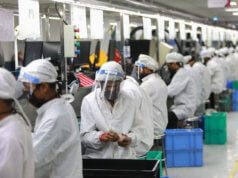The annual plans for 2013-14 of 24 states, out of 35 states and union territories in India, were finalised in consultation with the Planning Commission until June 26. The total approved outlay of Rs.530,491 crore of these 24 states and UTs marks an increase of 15.1 per cent for the year, the second year of the 12th Plan, against 17.7 per cent in the first year, 2012-13.
The following paragraphs set out the broad thrust areas charted by the state governments for their annual plans as also the 12th Plan, as culled out from relevant press handouts and state presentations to the Planning Commission.
In terms of the finalised outlay, Gujarat stands first with an outlay of Rs.59,000 crore among these states, followed by Andhra Pradesh with Rs.53000 crore and Maharashtra with Rs.49,000 crore. In terms of the pace of increase, Tamil Nadu stands first with 32.6 per cent hike over the approved outlay for 2012-13, followed by Madhya Pradesh with 26.8 per cent increase in outlay.
Andhra Pradesh (outlay: Rs.53,000 crore)
The Rs.342,842 crore outlay for the 12th Five-Year Plan (2012-2017) has underlined a big push for the industry sector, whose contribution to the state’s GSDP remained at around 25 per cent during the last decade. A targeted approach with focus on MSMEs and small industries for generation of employment through skill upgradation would be the core agenda for the plan. The state has targeted a growth rate of 10 per cent over the plan period. It would be broad-base growth involving all sectors and all sections of people. The chief minister requested the Planning Commission to push the Centre for expediting the implementation and completion of projects which have a major bearing on the development of the state. He also requested that the Indira Sagar Polavaram Project be given early revised investment clearance and the same along with Ambedkar Pranahita project be declared national projects.
Arunachal Pradesh (outlay: Rs.3,700 crore)
The Planning Commission was aware of the need to further improve transportation facility in the border areas and it would be given special attention in course of the year.
Assam (outlay: Rs.12,500 crore)
This state was advised to build Health Information System by networking all health service providers and establishing state-level disease surveillance systems. The state was also advised to use technology to reduce power losses. Innovative approach to create investment friendly environment in industry was also recommended. The state economy is expected to grow at 8 per cent during the 12th Plan.
Bihar (outlay: Rs.34,000 crore)
The state would be targeting a growth rate of 13 per cent in the 12th Plan which would include 7 per cent growth in agriculture for which a roadmap has been drawn. Drip and sprinkle irrigation would be encouraged to improve productivity. Infrastructure development, especially road, electricity and irrigation, would get top priority. Around 35 per cent of the total outlay for the 12th Plan has been earmarked for the social services sector consisting of education, health, water supply and sanitation, housing, urban development and other services. The next highest outlay has been proposed for the transport sector (18.34 per cent). In the total outlay for the annual plan, agriculture sector has been allotted 10 per cent and social services 41 per cent. Irrigation and flood control would get 8 per cent, energy 5 per cent, and transport and communication 18 per cent.
Delhi (outlay: Rs.16,626 crore)
Outlay for transport will increase by 46 per cent, forming 24 per cent of the annual plan investment, while health and medical services will get 62 per cent more, claiming 16 per cent of the total state outlay. Allocation for education will also go up by 29 per cent. The decline in groundwater levels due to rapid pace of urbanisation, resulting in reduced natural recharge to aquifers in NCT of Delhi, is a major concern. A world-class skill development centre is being set up at Jonapur under PPP in collaboration with ITE Singapore. The UT government has projected 10.5 per cent growth for the 12th Plan, against 10.3 per cent for the 11th Plan. Transport (24 per cent), medical and public health (16 per cent), urban development and housing (14 per cent), education (13 per cent), and water supply and sanitation (10 per cent) would be among the major sectors in terms of outlay for the annual plan. 2,800 MW is proposed to be added during the 12th Plan, increasing the total capacity to around 5,000 MW. Likewise, existing transformation capacity of 12000 MVA is planned to be increased to 16000 MVA with more new substations to meet the increasing demand for power.
Goa (outlay: Rs.4,715 crore)
The state’s performance in agriculture and allied sector needs improvement as the growth rate of agriculture is continuously declining when compared to the per capita income in other sectors. Social service focus would continue to be on tourism and related activities. Efforts are on to promote diversification of agriculture so as to make it a more economically viable activity. New initiatives in the annual plan would include encouragement for local production of vegetables and fruits. Midday meal scheme for class IX & X students and underground cabling of major towns will be taken up during the year.
Gujarat (outlay: Rs.59,000 crore)
The Gujarat government has planned for a second phase of growth initiative in the farm sector, including establishment of frontend facilities and a further thrust in animal husbandry. The state government raised issues where it felt the central government policies needed to be reviewed to improve resource allocation for efficiency and to avoid creating impediments for state development. In the Rs.283,623 crore outlay for the 12th Plan, the state government’s development vision will be guided by continued emphasis on human development and inclusive growth, while aiming at sustainable double-digit growth which is environmentally sustainable with harmonious and balanced development in agriculture, manufacturing and services. For the annual plan, social services, irrigation and flood control, transport and energy are major thrust areas.
Haryana Plan (outlay: Rs.27,072 crore)
For agricultural growth, Haryana has to focus more on horticulture, building storage capacities, including cold storages, and adoption of modern agricultural practices to enhance productivity, according to the Planning Commission. Agriculture policy should also focus on efficient use of water. To achieve the objective of faster, inclusive and sustainable growth in the 12th Five-Year Plan, the social services sector has been given the highest priority. The second highest priority has been accorded to the development of infrastructure of irrigation, power, roads and road transport, and projects under the economic stimulus package.
Himachal Pradesh (outlay: Rs.4,100 crore)
The state government has prepared a long-term vision for the development of tourism and has targeted to increase the contribution of tourism sector in the GSDP from the current level of 10 per cent to 15 per cent by 2020 by developing tourist friendly infrastructure in the 12th Plan. State has given first priority to social services sector with an outlay of Rs.1,371.40 crore (33.45 per cent). The second priority has been given to transport and communication sector with an outlay of Rs.865.14 crore (21.10 per cent) to link feasible villages with motorable roads and maintenance of existing infrastructure. Social services would claim 33 per cent, transport and communication 21 per cent, energy 15 per cent and agriculture 13 per cent of the annual plan.
Karnataka (outlay: Rs.47,000 crore)
The outlay for the 12th Plan for Karnataka would be Rs.255,250 crore. The SGDP growth for the plan is targeted at 7.6 per cent. Agriculture is expected to grow 4.5 per cent, industry 6.5 per cent and services 9 per cent over the plan period. Irrigation and flood control would account for 19 per cent; energy and agriculture 11 per cent each; and urban development and transport 10 per cent each in the annual plan outlay. The state was committed to providing adequate outlays for the sectors that contribute significantly to improving human development indices, especially education, health, women and child development, social welfare, housing, water supply and sanitation, and rural development. Systemic reforms in each of these sectors are being initiated to improve outcome indicators.
Kerala (outlay: Rs.17,000 crore)
Negative growth in agriculture is a matter of concern and the state should focus on accelerating growth in this sector, according to the Planning Commission. Kerala is facing acute problems due to ageing population and communicable and lifestyle diseases. A major concern facing the state was stated to be the Nitaqat Policy of Saudi Arabia, which can result in large-scale return of Keralites. According to the state government presentation, a third of the annual outlay would go for social services and 23 per cent for LSGI. Kerala Road Transport Project (phase-II), Kochi Metro, Thiruvananthapuram-Kozhikkode monorail, Kannur Airport, mobility hub, Vizhinjam port, and Capital Region Development Programme would be among the focus areas.
Madhya Pradesh (outlay: Rs.35,500 crore)
Social services would claim around 40 per cent of the annual outlay, and transport and roads, irrigation and flood control and energy, 10-11 per cent each. The state aims at becoming energy surplus by 2014 and would provide 24×7 power supply to non-agricultural consumers and 10 hours of quality power for agriculture. It would give focused thrust to solar, wind, small hydro and biomass power projects for this purpose. The largest solar project in the country will be inaugurated in August this year and five dedicated solar parks are being developed in PPP mode. Four new industrial corridors are also being developed. Industrial Township Act is being formulated and 20,000 hectares of land bank have been established. A new scheme covering drinking water, infrastructure sanitation, urban reforms, conservation of water bodies and conservation of heritage building has been launched with an outlay of Rs.2,367.41 crore in the 12th Plan. Over 9,000 km roads (Rs.26,000 crore) and 35 rail over-bridges have been undertaken through PPP mode. The upgradation of 13 industrial estates and creation of 27 greenfield industrial estates at a cost of Rs.3,550 crore has also been taken up. The state chief minister sought the Planning Commission’s support in getting adequate allocation of coal blocks and coal linkages, forest clearance for power projects, continuity in the present funding pattern of central share in Sarva Shiksha Abhiyan (SSA) and increasing central assistance for viability gap funding for infrastructure projects.
Maharashtra (outlay: Rs.49,000 crore)
Apart from the state plan, a PSE plan has been fixed at Rs.31.500 crore, raising the total to Rs.80,500 crore. Drought proofing and balanced industrial growth along with infrastructure development would be given priority in the annual plan. The state has proposed an allocation of Rs.5,200 crore in the district plan. The state government was advised to encourage and motivate the entrepreneurs in MSME sector to avail of the benefit of central sector schemes. Concerted efforts are needed to further improve the literacy rate and eliminate gender and social gap in school enrolment by end of the 12th Five-Year Plan by ensuring that educational opportunities are available to all segments of the society. In PSE plan, MSEB (generation, transmission and distribution), CIDCO and MMRDA would be major capex spenders.
Meghalaya (outlay: Rs.4,151 crore)
The state government was advised to undertake academic and governance reforms in the higher education system. Effort should also be made to fully exploit immense tourism and art and craft potential. The chief minister has sought the Planning Commission’s support for externally aided projects in water sector, green energy, new Shillong Township and forestry.
Mizoram (outlay: Rs.2,500 crore)
Irrigation coverage of net sown area is found to be very low, which needs to be accelerated. Social services would get 28 per cent, new land use policy (NLUP) 16 per cent, and transport 14 per cent of the outlay, according to the state government presentation. Electrification of all villages, concerted efforts for reduction of AT&C and T&D losses, and transmission, sub-transmission and distribution system improvements are among the thrust areas for the 12th Plan.
Nagaland (outlay: Rs.2,000 crore)
The planning process for the 12th Plan, which has targeted 9 per cent growth, has been directed at inclusive economic growth with special emphasis on agriculture and allied sector, power, connectivity including air, surface and railway, human resources development including skill development, development of backward and underdevelopment areas and planned urban centres.
Odisha (outlay: Rs.21,500 crore)
Major effort in the 12th Plan will be on improving human development indicators. Focus will also be on improving quality of education, healthcare, and food security. For faster and balanced socioeconomic development, the major focus of the state will be to develop critical infrastructure mainly bijli, sadak and pani and to set up public sector investments in high priority sectors such as agriculture, infrastructure and human development. Strengthening of core physical infrastructure with investment in irrigation, power, roads, bridges and railways would be among the focus areas for the annual plan. The chief minister has reiterated the state’s demand for special category status and pointed out that the state satisfied most of the criteria for Special Category Status except that it did not have an international boundary. More intense efforts are needed to improve basic amenities and address the problem of adverse child sex ratio, the Planning Commission said. Public-private partnership needs to be further encouraged in both physical and social infrastructure development.
Punjab (outlay: Rs.16,125 crore)
As the status of groundwater depletion in the state is alarming, with about 80 per cent blocks either critical or overexploited, Punjab needs to review its water policy and invest more in recharging of groundwater and renovation of water bodies and canal systems, the Planning Commission said. According to the state government presentation, social services would claim 37 per cent, energy 20 per cent, transport 13 per cent, and irrigation and flood control 7 per cent of the annual plan outlay. The annual plan focuses on development of infrastructure in power, roads and rural water supply and sanitation. Health and education also continue to be the thrust areas with special emphasis on girl child and women empowerment.
Rajasthan (outlay: Rs.40,500 crore)
Water security is a major challenge for the state and a careful approach was needed to meet future needs of the state, according to the Planning Commission. Concerted efforts are needed to improve the literacy rate and eliminate gender and social gap in school enrolment by end of the 12th Plan. The literacy rate of the state is 67.06 per cent as per the 2011 census which is below the national average of 74.04 per cent. The state government has adopted a multipronged approach for socioeconomic development of scheduled tribes in the state. According to the state government presentation, one-third of the outlay would be for power sector and 38 per cent for social and community services,
Sikkim (outlay: Rs.2,060 crore)
The first priority has been given to rural development sector by proposing an outlay of 35.84 per cent. It includes schemes for land reforms, rural infrastructure and employment schemes. According to the state government presentation, the state would grow at 8.4 per cent over the 12th Plan period.
Tamil Nadu (outlay: Rs.37,128 crore)
It was noted that power sector performance would be critical as the state is currently suffering from a large deficit. The core focus of the 12th Plan is on accelerated, sustainable and inclusive growth. The size of the total state outlay is pegged at Rs.2.11 lakh crore for the 12th Plan. The allocation for the primary sector has been increased by 20.12 per cent, scheduled cast sub-plan by 15.29 per cent, and tribal sub-plan by 40 per cent in the annual plan.
Tripura (outlay: Rs.2,500 crore)
Social services, irrigation and flood control, special area development and transport are thrust areas for the annual plan. The state government was advised to adopt investment friendly policies aimed at encouraging private participation in both physical and social infrastructure development. Need to focus on health and education was also emphasised. The state government would give emphasis on strengthening trade, commerce, economic and cultural ties with Bangladesh during the 12th Plan so as to give necessary fillip to the economy. The state government has targeted 7.9 per cent growth for the 12th Plan.
Uttarakhand (outlay: Rs.8,500 crore)
The state needs to further encourage private sector participation in infrastructure development, the Planning Commission has advised. It has recognised the relevance of developing Tehri Dam area as an international tourism destination and asked the state government to give a full presentation on the project so as to evolve a plan to fund this project. The chief minister has requested special grant to provide civil amenities for tourists and pilgrims. Drawing attention to the problems being faced in the development of physical infrastructure, the chief minister said more than 200 villages are situated at the mouth of landslides and it would need more than Rs.500 crore to relocate and rehabilitate these villages before disaster strikes (and, indeed, as it has in recent days). The growth rate for the 12th Plan has been projected at 9 per cent, which would call for public sector outlay of Rs.50,000 crore approximately.
Uttar Pradesh (outlay: Rs.69,200 crore)
The UP government would spend more than 20 per cent of the annual outlay on economic infrastructure, which includes 9 per cent for irrigation and a little less than 6 per cent each for power and transport. The government is also proposing to spend 32 per cent of outlay on social infrastructure including 12 per cent for housing and urban development. Industry and agriculture and allied activities have been allocated 8 per cent each. All district headquarters would be connected by four-lane roads by end of the annual plan while all 500-plus habitations will be connected with all-weather roads in two years. The state’s heavy dependence on groundwater for irrigation is cited as a major cause of concern.
West Bengal (outlay: Rs.30,314 crore)
The basic objective of the 12th Plan is faster, more inclusive and sustainable growth. Accordingly, social services sector has been allocated highest outlays. Sectors like energy, irrigation and transport and rural development have also been accorded high priority in terms of financial allocation. Special area programmes have also been paid consideration through targeted development in Jangal Mahal, Sundarbans, Hills, North Bengal etc.











